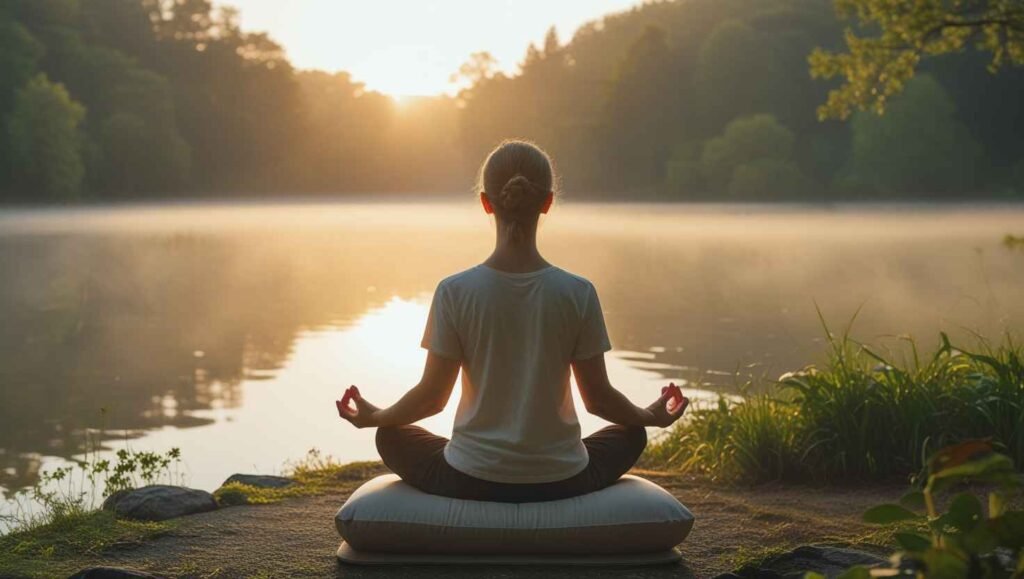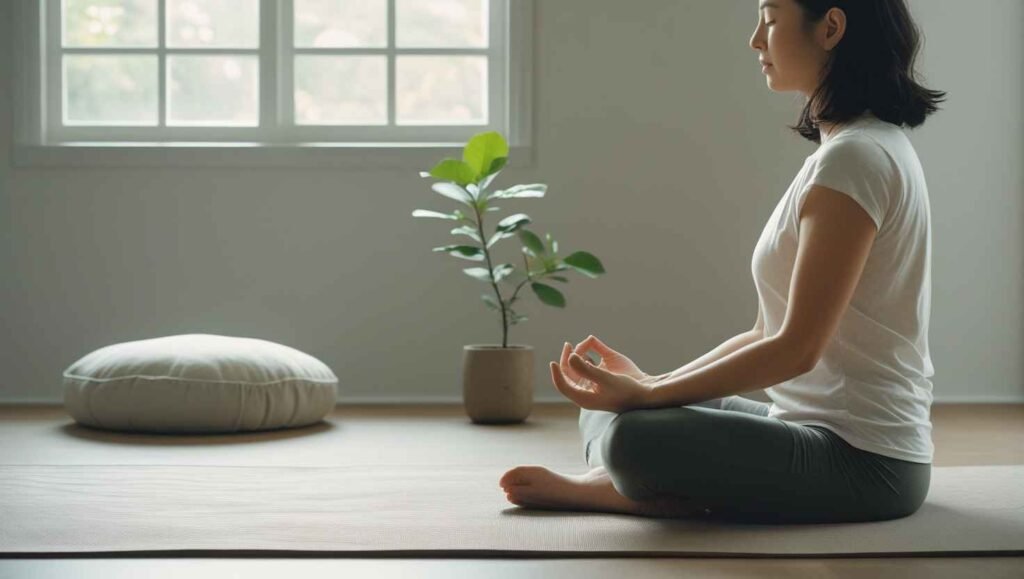In today’s busy world, stress and worry are common problems. A mindfulness meditation guide can help you cultivate a calm and peaceful mind. If you want to improve your focus, reduce stress, and live a more fulfilling life, then this mindfulness meditation guide is for you.
What is Mindfulness Meditation?
Mindfulness meditation means paying attention to what is happening right now without thinking if it is good or bad. This mindfulness meditation guide will help you understand the basics, benefits, and techniques to incorporate mindfulness into your daily routine. By practicing mindfulness, you learn to be fully aware of your thoughts, emotions, and surroundings.
Benefits of Following a Mindfulness Meditation Guide

Mindfulness meditation can be very good for your mind, feelings, and body. Here’s how a simple guide can help you:
- Reduces Stress and Anxiety – Mindfulness meditation helps lower cortisol levels, the stress hormone, which results in a relaxed mind.
- Improves Focus and Concentration – By training your mind to stay in the present moment, you enhance your ability to focus.
- Boosts Emotional Health – Regular practice fosters self-awareness, allowing you to regulate your emotions better.
- Enhances Sleep Quality – A peaceful mind leads to better sleep patterns and reduces insomnia.
- Promotes Physical Health – Mindfulness has been linked to lower blood pressure, improved immunity, and reduced chronic pain.
Easy Steps to Begin Mindfulness Meditation

If you’re new to mindfulness, this mindfulness meditation guide will walk you through simple steps to get started:
1. Find a Quiet Place
To begin, choose a quiet and comfortable space where you won’t be disturbed. A peaceful environment helps enhance focus during your mindfulness practice.
2. Sit Comfortably
You can sit on a chair, cushion, or floor. Keep your back straight and your hands resting on your lap. Sit or stand comfortablyon a meditation mat, but stay ready and aware.
3. Focus on Your Breath
Start by taking slow, deep breaths.Take a deep breath in through your nose, then let it out through your mouth.. This mindfulness meditation guide encourages you to observe each breath without trying to change it.
4. Acknowledge Your Thoughts
It’s natural for thoughts to arise. Instead of resisting them, acknowledge them and gently bring your focus back to your breath.
5. Practice Regularly
Consistency is key. Even practicing mindfulness meditation for 5–10 minutes daily can bring noticeable improvements in your well-being.
Mindfulness Meditation Guide for Beginners
If you’re a beginner, this mindfulness meditation guide provides easy techniques to follow:
- Body Scan Meditation – Focus on different parts of your body to release tension and increase awareness.
- Mindful Breathing – Focus on your breathing, in and out.
- Guided Meditation – Listen to recorded sessions that guide you through the process.
- Mindful Walking – Engage all your senses while walking slowly and attentively.
- Gratitude Meditation – Reflect on positive aspects of your life to enhance emotional well-being.

Advanced Techniques in This Mindfulness Meditation Guide
Once you get comfortable with the basics, try these advanced techniques:
- Loving-Kindness Meditation – Think of kind and happy thoughts for yourself and others.
- Zen Meditation (Zazen) – A seated meditation that involves deep concentration.
- Vipassana Meditation – Observing thoughts and sensations without attachment.
- Mantra Meditation – Repeating a positive phrase to maintain focus.

Common Challenges and Solutions in Mindfulness Meditation
Many people struggle when they first start mindfulness meditation. This mindfulness meditation guide addresses common challenges:
- Difficulty Staying Focused – Start with shorter sessions and gradually increase duration.
- Restlessness – If you feel restless, try mindful walking before sitting meditation.
- Impatience – Understand that mindfulness is a journey, not an instant solution.
- Distractions – Accept distractions and gently redirect your focus.
Easy Ways to Be Mindful Every Day
Mindfulness is more than just meditation; it’s a way of living. Here’s how this mindfulness meditation guide can help you integrate mindfulness into your daily activities:
- Mindful Eating – Savor each bite, eat slowly, and appreciate your food.
- Mindful Listening – Pay full attention when talking to others.
- Mindful Working – Pay attention to one task at a time, don’t try to do too many things at once.
- Mindful Walking – Feel the ground beneath your feet and observe your surroundings.
- Mindful Gratitude – Reflect on things you’re grateful for each day.

Your Journey with This Mindfulness Meditation Guide.

This mindfulness meditation guide is designed to help you embark on a journey toward inner peace, clarity, and emotional balance. By practicing mindfulness daily, you’ll cultivate a sense of calm and presence in everything you do. Start with small steps, be patient with yourself, and enjoy the process of becoming more mindful.
Mindfulness is a gift that allows you to embrace the present moment fully. Follow this mindfulness meditation guide, and you’ll experience a positive transformation in your mind and body. Happy meditating!
Table of Contents
Please read our best article Morning Rituals for a Healthy Start: Begin Your Day with Positivity and Energy


Mindfulness meditation sounds like a simple yet powerful tool for improving overall well-being. I appreciate how it emphasizes the importance of a quiet space and consistency, which are often overlooked. Acknowledging thoughts without resistance seems like a healthy approach to managing mental clutter. I wonder, though, how long it usually takes to see significant changes in one’s mental state? The idea of starting with just 5–10 minutes daily feels manageable, but I’m curious if there’s a recommended time frame for advancing to more complex techniques. What’s your experience with mindfulness meditation? Have you noticed any specific benefits or challenges? I’d love to hear more about how it has worked for you!
Mindfulness meditation seems like a simple yet powerful tool for improving overall well-being. I’ve tried it a few times, but I often struggle with staying focused—my mind just keeps wandering. Do you have any tips for someone who finds it hard to quiet their thoughts? I’m curious, how long did it take for you to notice the benefits of consistent practice? Also, what are some of the advanced techniques you mentioned? I’d love to hear more about how they’ve worked for you. Do you think mindfulness meditation can really make a big difference in managing stress or anxiety?
Mindfulness meditation seems like a simple yet powerful tool for improving overall well-being. I appreciate the emphasis on starting small with just 5–10 minutes daily—it makes the practice feel accessible. The idea of acknowledging thoughts without resistance is intriguing and feels more realistic than trying to completely clear the mind. I wonder, though, how long it typically takes to notice significant changes in mental clarity or stress levels? The suggestion to try advanced techniques once comfortable with the basics is motivating, but what exactly do those techniques involve? It’s refreshing to see such a straightforward guide, but I’d love to hear about personal experiences—has anyone tried this and felt a difference? What’s your take on the importance of the environment in mindfulness practice—does it really make or break the experience?